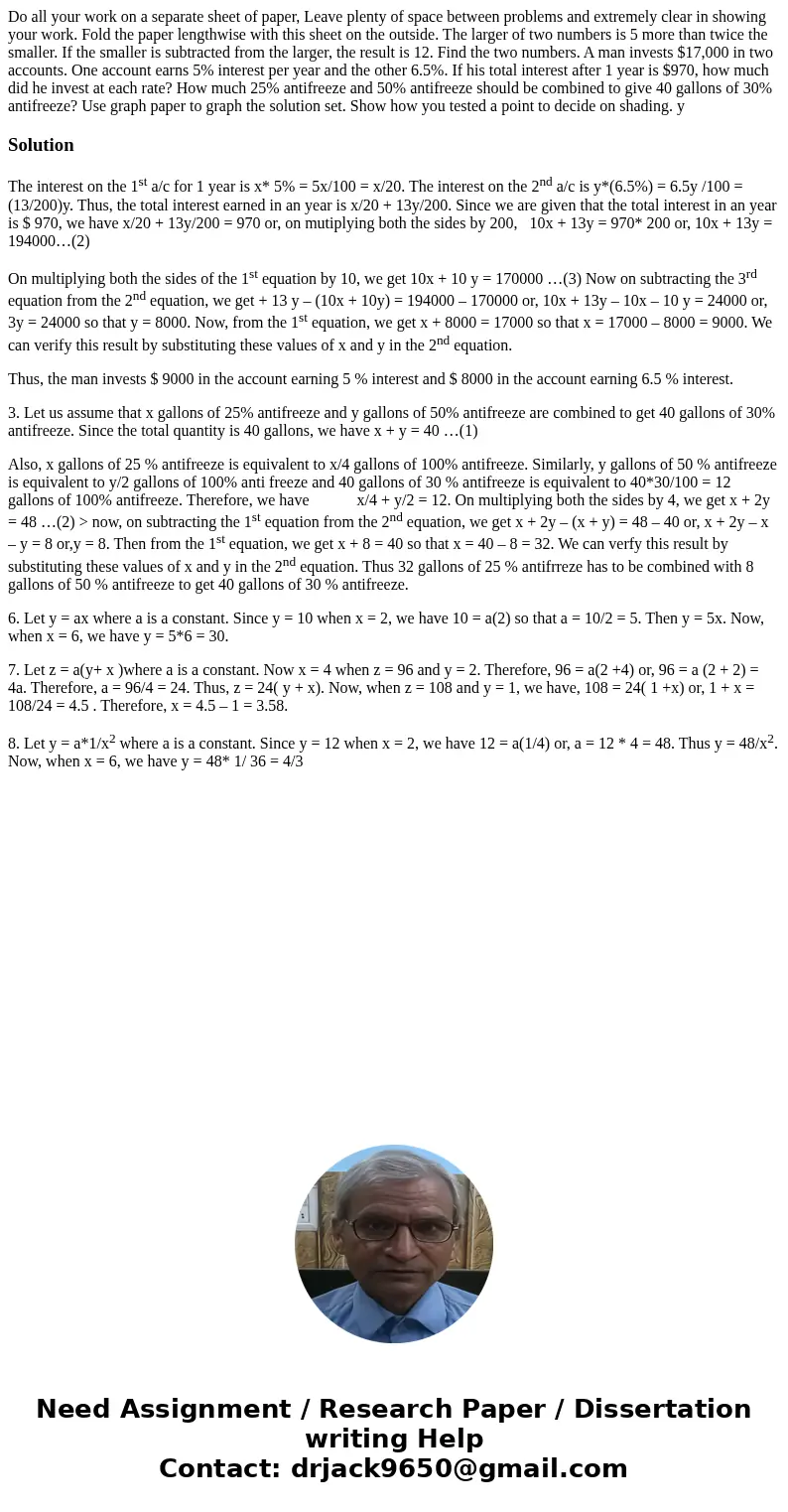Do all your work on a separate sheet of paper Leave plenty o
Solution
The interest on the 1st a/c for 1 year is x* 5% = 5x/100 = x/20. The interest on the 2nd a/c is y*(6.5%) = 6.5y /100 = (13/200)y. Thus, the total interest earned in an year is x/20 + 13y/200. Since we are given that the total interest in an year is $ 970, we have x/20 + 13y/200 = 970 or, on mutiplying both the sides by 200, 10x + 13y = 970* 200 or, 10x + 13y = 194000…(2)
On multiplying both the sides of the 1st equation by 10, we get 10x + 10 y = 170000 …(3) Now on subtracting the 3rd equation from the 2nd equation, we get + 13 y – (10x + 10y) = 194000 – 170000 or, 10x + 13y – 10x – 10 y = 24000 or, 3y = 24000 so that y = 8000. Now, from the 1st equation, we get x + 8000 = 17000 so that x = 17000 – 8000 = 9000. We can verify this result by substituting these values of x and y in the 2nd equation.
Thus, the man invests $ 9000 in the account earning 5 % interest and $ 8000 in the account earning 6.5 % interest.
3. Let us assume that x gallons of 25% antifreeze and y gallons of 50% antifreeze are combined to get 40 gallons of 30% antifreeze. Since the total quantity is 40 gallons, we have x + y = 40 …(1)
Also, x gallons of 25 % antifreeze is equivalent to x/4 gallons of 100% antifreeze. Similarly, y gallons of 50 % antifreeze is equivalent to y/2 gallons of 100% anti freeze and 40 gallons of 30 % antifreeze is equivalent to 40*30/100 = 12 gallons of 100% antifreeze. Therefore, we have x/4 + y/2 = 12. On multiplying both the sides by 4, we get x + 2y = 48 …(2) > now, on subtracting the 1st equation from the 2nd equation, we get x + 2y – (x + y) = 48 – 40 or, x + 2y – x – y = 8 or,y = 8. Then from the 1st equation, we get x + 8 = 40 so that x = 40 – 8 = 32. We can verfy this result by substituting these values of x and y in the 2nd equation. Thus 32 gallons of 25 % antifrreze has to be combined with 8 gallons of 50 % antifreeze to get 40 gallons of 30 % antifreeze.
6. Let y = ax where a is a constant. Since y = 10 when x = 2, we have 10 = a(2) so that a = 10/2 = 5. Then y = 5x. Now, when x = 6, we have y = 5*6 = 30.
7. Let z = a(y+ x )where a is a constant. Now x = 4 when z = 96 and y = 2. Therefore, 96 = a(2 +4) or, 96 = a (2 + 2) = 4a. Therefore, a = 96/4 = 24. Thus, z = 24( y + x). Now, when z = 108 and y = 1, we have, 108 = 24( 1 +x) or, 1 + x = 108/24 = 4.5 . Therefore, x = 4.5 – 1 = 3.58.
8. Let y = a*1/x2 where a is a constant. Since y = 12 when x = 2, we have 12 = a(1/4) or, a = 12 * 4 = 48. Thus y = 48/x2. Now, when x = 6, we have y = 48* 1/ 36 = 4/3

 Homework Sourse
Homework Sourse